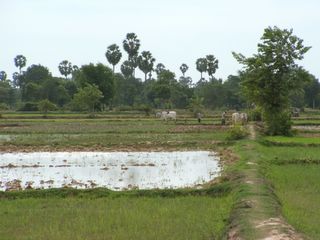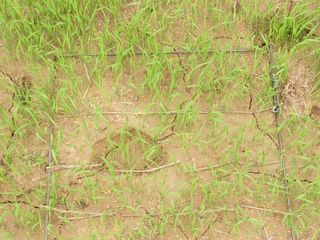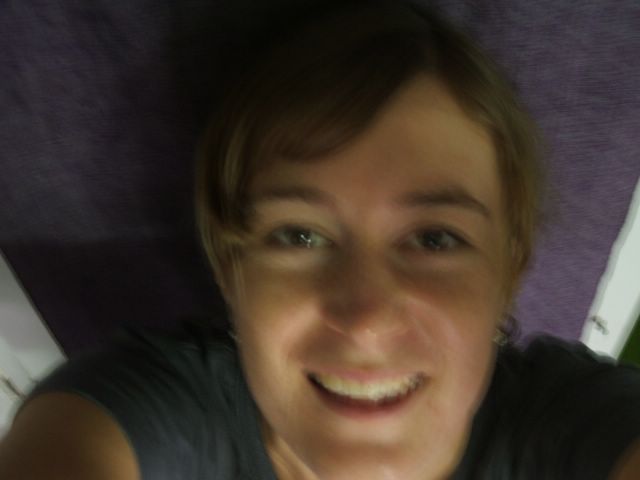Field Notes Part 1
We cruise into Takeo in our shiny, white landcruiser at 9.30am and stop for a brief meeting at our Provincial head office with Phal the Takeo Coordinator. Half an hour later we are back on the road with one ute, one landcruiser and six people (including two drivers) off to Sam Rauon village. Once in the village we are invited to sit on a wooden slat bed under the house of the key village member involved in the project. Phal introduces me, explains what I am doing and asks if there are any questions. The family smile and say no, they have already established what they want to know. Phal explains to me that they asked the most pressing question on arrival, as I was getting out of the car. This was ofcourse: “Is she married?”. We get down to business.
This is the first in a series of visits I am undertaking through the project areas in south-east of Cambodia. The aim is to look at the quality of rice seed used by everyday farmers. To do this, we are collecting small samples of seed and also conducting some field tests if the farmer has planted her/his seed recently. We are now in rainy season, and true to form it starts to bucket down soon after I settle on the wooden slats. But the downpour only lasts ten minutes. It’s raining, but not enough. The past five years have been characterised by severe drought after severe drought. This has made the already difficult life of the Khmer farmer even more desperate, and in Takeo it is even worse than in other areas of the country. Currently farmers in Takeo are faced with the gamble of planting now and hoping enough rain falls or waiting until the season really sets in and hoping it holds out. This is a risk that involves extremely high stakes. I survey the palm lined paddy fields and wooden stilt houses; it looks peaceful and picturesque, but there are some very harsh realities that underlie this panorama.

One of the rice paddies we were working in.
I ask the family questions about their rice seed and their farm. They happily answer. This family have had their seed for 20 years. Each year they save some of their harvest, store it for 9 months, and then clean and dry it ready to plant into the earth again. Vichet and I go out into their field and place down our metal rod 0.25m by 0.25m squares. I squat on my haunches and slowly count the amount of rice plants in my square. I ask Vichet how to say “working under the hot sun” in Khmer. He laughs and tells me. For eighty percent of Cambodians this is just life, but for this pasty faced, white girl these conditions are somewhat novel.

Vichet, my counterpart, working under the hot Cambodian sun.

close-up of my counting square
Later that evening I talk with Phal about his perceptions of agricultural practices over the past 20 years. He tells me that less people are transplanting (growing rice in a nursery and then planting in the field once the seedlings are established) as costs have risen so much and labour is too expensive. This is compounded by the not insignificant flow of young women out of rural villages and into outer areas of Phnom Penh and Kandal to work in huge textile factories. This has reduced available family labour for farmers who just do not have the money to hire help. This has real ramifications for the yield that farmers get on their crops and the amount of food they have to feed their families.
After the morning in Sam Rouen we head to a village further north. I ask Chandra, our driver, how far it is. He informs me that it is 16km.
“Oh, so if we are meeting Mar Ouen there at 2pm we don’t need to leave for half an hour?”
Chandra shakes his head. The road is bad and it will take 40 minutes. We need to leave straight away. There has been a significant improvement in the roads through Cambodia, even in a year, and definitely since I first came here in 2001. However, the smooth, mud free, bitumen expanses tend to only be found on very major routes. Takeo to Kompong Thnal is definitely not one of these. The bad road is bad due to some serious mud, creating a majorly churned up, treacherous surface. I learn how to say the car is “bouncing all over the place” in Khmer, which sounds something like the English word “roulette”. It’s certainly a gamble whether we are going to make it to this village without getting bogged or overturning the vehicle. We make it, and I crack everyone up by using the roulette word incorrectly and saying the “road was bouncing all over the place”. Surely it is a matter of perspective?
This is the first in a series of visits I am undertaking through the project areas in south-east of Cambodia. The aim is to look at the quality of rice seed used by everyday farmers. To do this, we are collecting small samples of seed and also conducting some field tests if the farmer has planted her/his seed recently. We are now in rainy season, and true to form it starts to bucket down soon after I settle on the wooden slats. But the downpour only lasts ten minutes. It’s raining, but not enough. The past five years have been characterised by severe drought after severe drought. This has made the already difficult life of the Khmer farmer even more desperate, and in Takeo it is even worse than in other areas of the country. Currently farmers in Takeo are faced with the gamble of planting now and hoping enough rain falls or waiting until the season really sets in and hoping it holds out. This is a risk that involves extremely high stakes. I survey the palm lined paddy fields and wooden stilt houses; it looks peaceful and picturesque, but there are some very harsh realities that underlie this panorama.

One of the rice paddies we were working in.
I ask the family questions about their rice seed and their farm. They happily answer. This family have had their seed for 20 years. Each year they save some of their harvest, store it for 9 months, and then clean and dry it ready to plant into the earth again. Vichet and I go out into their field and place down our metal rod 0.25m by 0.25m squares. I squat on my haunches and slowly count the amount of rice plants in my square. I ask Vichet how to say “working under the hot sun” in Khmer. He laughs and tells me. For eighty percent of Cambodians this is just life, but for this pasty faced, white girl these conditions are somewhat novel.

Vichet, my counterpart, working under the hot Cambodian sun.

close-up of my counting square
Later that evening I talk with Phal about his perceptions of agricultural practices over the past 20 years. He tells me that less people are transplanting (growing rice in a nursery and then planting in the field once the seedlings are established) as costs have risen so much and labour is too expensive. This is compounded by the not insignificant flow of young women out of rural villages and into outer areas of Phnom Penh and Kandal to work in huge textile factories. This has reduced available family labour for farmers who just do not have the money to hire help. This has real ramifications for the yield that farmers get on their crops and the amount of food they have to feed their families.
After the morning in Sam Rouen we head to a village further north. I ask Chandra, our driver, how far it is. He informs me that it is 16km.
“Oh, so if we are meeting Mar Ouen there at 2pm we don’t need to leave for half an hour?”
Chandra shakes his head. The road is bad and it will take 40 minutes. We need to leave straight away. There has been a significant improvement in the roads through Cambodia, even in a year, and definitely since I first came here in 2001. However, the smooth, mud free, bitumen expanses tend to only be found on very major routes. Takeo to Kompong Thnal is definitely not one of these. The bad road is bad due to some serious mud, creating a majorly churned up, treacherous surface. I learn how to say the car is “bouncing all over the place” in Khmer, which sounds something like the English word “roulette”. It’s certainly a gamble whether we are going to make it to this village without getting bogged or overturning the vehicle. We make it, and I crack everyone up by using the roulette word incorrectly and saying the “road was bouncing all over the place”. Surely it is a matter of perspective?

0 Comments:
Post a Comment
<< Home